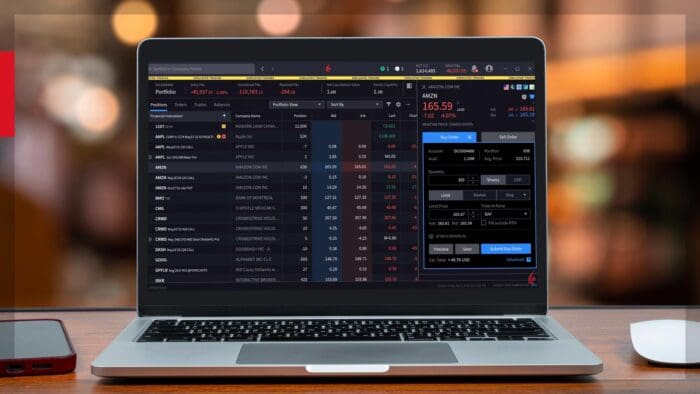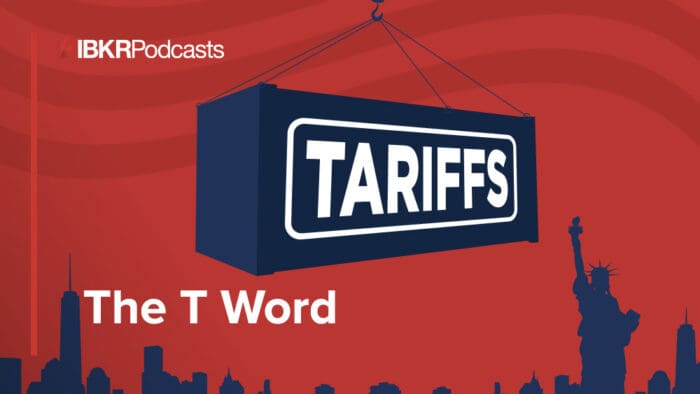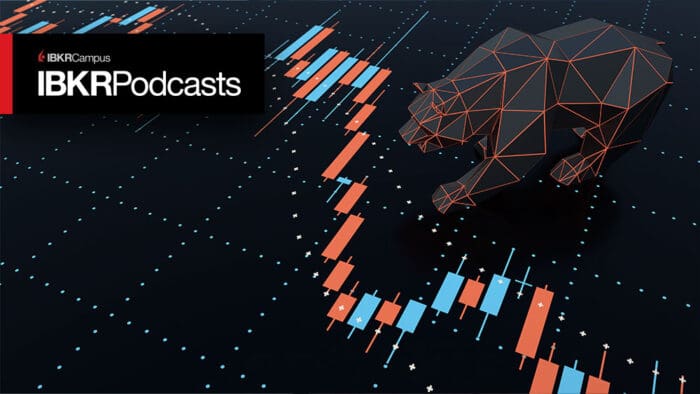Will McBride and Dmitry Pargaminik, cofounders of Market Chameleon join IBKR’s Senior Trading Education Specialist Jeff Praissman to discuss implied volatility and its effect on option pricing.
Contact Information:
Note: Any performance figures mentioned in this podcast are as of the date of recording (June 5, 2023).
Summary – IBKR Podcasts Ep. 83
The following is a summary of a live audio recording and may contain errors in spelling or grammar. Although IBKR has edited for clarity no material changes have been made.
Jeff Praissman
Welcome to IBKR Podcasts. I’m your host, Jeff Praissman, Interactive Broker’s Senior Trading Education Specialist, and it’s my pleasure to welcome back the Co-founders of Market Chameleon, Will McBride and Dmitry Pargamanik. Hey guys, how are you?
Dmitry Pargaminik
Hey, Jeff. Good, thanks for having us, Jeff.
Will McBride
Hey, Jeff. Thanks for having us for sure. Great to be back.
Jeff Praissman
My pleasure, it’s always great to have you guys back in the studio. Before we get started though, I just wanted a quick note to our listeners, please rate and review our podcasts. We appreciate the feedback. And today Will, Dmitry, we’re going to discuss implied volatility and the effect it has on option pricing. So, I think just to kind of get started, let’s start with the definition of implied volatility.
Dmitry Pargaminik
Sure. So the implied volatility, what is the most important thing to understand about implied volatility is that it is a metric, it’s derived, it’s a derived value coming from option prices. I think a lot of people maybe mix that up, you know, I hear people say, well, what is the implied volatility of Apple? But, implied volatility, it’s not an inherent attribute of a stock, right? It is something that’s derived, and you use a model to derive that value. So for an example, when we say what is your car insurance? Well, the car itself doesn’t have insurance. Insurance is something that you buy, you buy a policy on your car and the price of that policy can indicate if you’re high risk or low risk and that’s what implied volatility is trying to indicate. Is there a high-risk future volatility in the stock or are the expectations that the volatility, the realized volatility of the stock, forward volatility, is going to be low or high? So, it’s really trying to indicate, market indicator, of what the future volatility of a certain underlying is projected to be using that option price.
Jeff Praissman
So, what factors into the calculation of the implied volatility?
Dmitry Pargaminik
So, when we look at the option pricing model there are a couple of important inputs in there. You do need the stock price, strike price, days to expiration, interest rates, dividends and a lot of these are assumptions and when we take a model for example and try to work or reverse engineering by putting in an option price into the model and trying to figure out what is the anticipated volatility of the stock? And each model can be a little bit different than somebody else’s because we are putting in assumptions there. It could be an interest rate assumption, a dividend assumption, even something like days to expiration can be a little bit different because. Somebody could use calendar days. Other people could use trading days and then maybe you make adjustments. For example, half a day or maybe you even adjusted as the day goes along. So, when we do look at the output of the model, implied volatility, it can vary from model to model.
Jeff Praissman
So, within option pricing, how big of a role I guess does implied volatility play within the price of an option and it sounds like it can be updated kind of constantly as other factors change as well … that are being put input into that model that creates the implied volatility.
Dmitry Pargaminik
It’s a big component for option pricing, but it’s not the only component and I think the important thing to understand about implied volatility and the model is that when you use that model and you get an output, the model doesn’t know how you’re going to use that output. It doesn’t know your strategy, doesn’t know what your intended purpose is. And if you use it incorrectly, it’s not going to be an appropriate metric to use. And I do see that a lot of times where people are taking the implied volatility and assume something that isn’t correct and apply it to a strategy that would be inappropriate. And like any model, it has its limitations, right? It has its limitations and its assumptions. 2 of the biggest assumptions it has is that the stock returns are going to be logged normally, distributed and that there is constant volatility. And if that doesn’t hold true, if your strategy or the market, the stock deviates from that path then the implied volatility is not very useful. And when we look at implied volatility itself, the model is assuming that you’re trading volatility, not direction in the stock. So, it is assuming that you’re going to take the way the model was intended by trading the gamma, the delta, all the Greeks of the model to basically scalp the realized volatility versus implied volatility.
Jeff Praissman
So, when a trader’s looking at implied volatility, it doesn’t really indicate the direction the underlying will go, it just depending on the value, it indicates the assumption how much it may move in either direction versus staying stagnant or being relatively unchanged.
Dmitry Pargaminik
Exactly. The implied volatility, that’s what it’s indicating. It’s suggesting what is the stock going to fluctuate between now and the end of the term on, it gives you the daily average volatility between now and the term. So, we could have an option that between now and expiration, it could actually end up being worthless at expiration, but if the volatility in between now and then was very high and you traded the model, it could have been a very profitable strategy because whatever you lost on the decay and in the option you made-up trading to realized volatility.
Jeff Praissman
I want to go back to you know, you discussed the determining factors earlier of implied volatility, one of which was time to maturity. And I know in in former podcasts, the three of us have discussed, like the short dated options, the zero-dated options, like how popular they are. So, since implied volatility measures the likelihood of the change of the price of security, is it safe to say that it has a greater effect on longer data adoptions over shorter term options with all factors being equal?
Dmitry Pargaminik
Right. If you look at the options, short data versus longer dated options, the model tells us how sensitive an option is to change in implied volatility. We call it the Vega. The further you go out in time; the more sensitive options are to a change in implied volatility. So, what a 1% implied volatility Vega change in a very short dated option might be very small compared to a 1% change in the Vega of a longer dated option, and they don’t match up across the term structure. So, you could have on a very short dated option, you change the implied volatility by 1 and that could impact that option by perhaps a penny or two pennies. While you go out longer dated options, let’s say a year and a one percentage implied volatility change in that option could impact that option by $0.50 – $1 or so forth. The sensitivity of an option price to change implied volatility increases as you go out further in time.
Jeff Praissman
With the short dated and zero-dated options then, it sounds like implied volatility really has a minimal effect and almost doesn’t matter, but it doesn’t have nearly the effect if you’re trading a leap or, you know, something further out. So, what do you think the main driving force behind the pricing of these short term options are then if implied volatility really has such a minimum impact?
Dmitry Pargaminik
Right, when we go to zero-dated or 0DTE option that expires today, the implied volatility becomes almost negligible because you’re not likely to trade your gamma intraday. It’s impractical, especially if you’re going to incur a lot of commissions trading. So, the 0DTE options is really how you project what the stock will move between now and the end of the day and what becomes more important are other factors that could drive that movement. For example, maybe, if you look at the economic calendar and you see that there was going to be a Fed meeting, interest rates or something that could either move the market or the stock, then you would use that data to perhaps project a bigger than normal move. Or maybe news that’s coming out that day in the morning, unanticipated news like a war could make the market or any stock move much more than usual, so those become bigger factors in pricing a 0DTE. And other factors may be where you may either spread off the options versus each other or like assets for example, maybe you could price one option versus a different option in a different asset class that are very similar, right. And then use different types of models, perhaps that are more I would say, pertinent in those situations than the implied volatility itself, because the implied volatility at that point does not mean as much because you’re not looking at daily fluctuations any longer, but very short-term periods. And as the date is closer and closer the implied volatility is not that meaningful anymore.
Jeff Praissman
How can a trader and investor use implied volatility compared to, say, historical volatility for option trading ideas?
Dmitry Pargaminik
Yeah, when we look at implied volatility and use it as a metric a lot of times what we try to do is determine, is the implied volatility high or low? And to make that determination, one of the ways we could start comparing it — we’d have to compare it to something, right. Either to itself or it’s to historical volatility and a common way to compare what is the expected future volatility relative to how this underlying asset fluctuated in the past, that’s the historical volatility. And if you see that they deviate they’re apart from each other, that could perhaps signal that the implied volatility has gotten a little bit either ahead of itself or has been pushed down to a very low level. So that’s one of the ways options traders will use historical volatility as a reference against the implied volatility.
Jeff Praissman
You know, Dmitry, Will, this has been great. I just want to remind our viewers that Market Chameleon are a frequent contributor to the IBKR Campus with monthly webinars and podcasts. To see more educational material for Market Chameleon go to ibkr.com, click on “Education” in the top right and IBKR Campus and click on our contributors and look for Market Chameleon. You can also subscribe to Market Chameleon research directly through Interactive Brokers. And all our podcasts can be found on our website under the “Education” tab or Spotify, Apple Music, Amazon Music, PodBean, Google Podcasts, and Audible. Thank you for listening until next time, I’m Jeff Praissman with Interactive Brokers.
Disclosure: Interactive Brokers
The analysis in this material is provided for information only and is not and should not be construed as an offer to sell or the solicitation of an offer to buy any security. To the extent that this material discusses general market activity, industry or sector trends or other broad-based economic or political conditions, it should not be construed as research or investment advice. To the extent that it includes references to specific securities, commodities, currencies, or other instruments, those references do not constitute a recommendation by IBKR to buy, sell or hold such investments. This material does not and is not intended to take into account the particular financial conditions, investment objectives or requirements of individual customers. Before acting on this material, you should consider whether it is suitable for your particular circumstances and, as necessary, seek professional advice.
The views and opinions expressed herein are those of the author and do not necessarily reflect the views of Interactive Brokers, its affiliates, or its employees.
Disclosure: Options Trading
Options involve risk and are not suitable for all investors. For information on the uses and risks of options, you can obtain a copy of the Options Clearing Corporation risk disclosure document titled Characteristics and Risks of Standardized Options by going to the following link https: ibkr.com/occ. Multiple leg strategies, including spreads, will incur multiple transaction costs.














Join The Conversation
For specific platform feedback and suggestions, please submit it directly to our team using these instructions.
If you have an account-specific question or concern, please reach out to Client Services.
We encourage you to look through our FAQs before posting. Your question may already be covered!